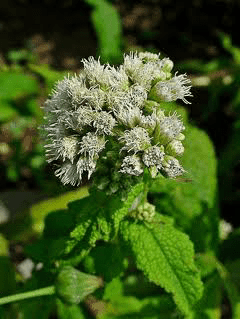Eupatorium perfoliatum, commonly known as Boneset, is a fascinating medicinal plant that has been used for centuries for its numerous health benefits. In this article, we will delve into the rich history of this plant’s medicinal use, its botanical description, and explore the various ways it can contribute to our well-being.
The history of Eupatorium perfoliatum as a medicinal plant is a tapestry woven with traditions, anecdotes, and scientific discoveries. This section will take you on a journey through time, tracing the roots of its use in different cultures and its evolution into a prominent herbal remedy.
The Botanical Description of Eupatorium perfoliatum
Eupatorium perfoliatum is a herbaceous perennial plant that belongs to the Asteraceae family. Understanding its botanical features is essential for identifying and appreciating this remarkable medicinal herb. Here are seven key aspects of its botanical description:
1. Family and Genus: Eupatorium perfoliatum belongs to the family Asteraceae, which is often referred to as the aster, daisy, or sunflower family. The genus Eupatorium encompasses over 40 species, with Eupatorium perfoliatum being one of its notable members.
2. Common Name: As mentioned earlier, Eupatorium perfoliatum is commonly known as Boneset due to its historical use in treating aching bones and fevers. This name reflects its significance in traditional herbal medicine.
3. Habitat: Eupatorium perfoliatum is native to North America and is often found in damp or marshy areas. It thrives in moist soil and is commonly spotted along the edges of ponds, streams, and in low-lying meadows.
4. Growth Habit: This medicinal plant exhibits a distinctive growth habit. Its stems are square-shaped, a characteristic feature of plants in the Asteraceae family. The stems can reach a height of 3 to 4 feet (0.9 to 1.2 meters) and are covered with serrated, lance-shaped leaves.
5. Leaves: The leaves of Eupatorium perfoliatum are arranged in pairs along the stem, and they are perfoliate, meaning the stem appears to pierce through the center of the leaves. These leaves are typically dark green, coarsely toothed, and have a slightly wrinkled texture.
6. Flowers: The plant produces clusters of small, white, or pale pink flowers that form a flat-topped inflorescence. This bloom structure is characteristic of Eupatorium perfoliatum and is a key feature for identification.
7. Medicinal Parts: The aerial parts of Eupatorium perfoliatum, including the leaves and flowering tops, are the primary parts used for medicinal purposes. These plant parts are harvested in late summer or early autumn when the plant is in full bloom and at its medicinal peak.
The Geographic Distribution of Eupatorium perfoliatum
Eupatorium perfoliatum, also known as Boneset, has a wide geographical distribution across North America. Here, we will explore eight key aspects of its geographic range and where it can be found:
1. North American Native: Eupatorium perfoliatum is a native plant to North America. Its natural habitat spans from eastern Canada to the southeastern United States.
2. Eastern United States: This medicinal plant is particularly abundant in the eastern regions of the United States, including states like Florida, Georgia, and the Carolinas.
3. Wetland Environments: Boneset thrives in wetland environments, often found in low-lying areas near streams, rivers, and ponds. It prefers damp, marshy soils, making it a common sight in these habitats.
4. Range Expansion: While Boneset’s native range is in North America, it has been introduced and naturalized in parts of Europe and Asia. This expansion reflects its adaptability and resilience.
5. Distinctive Clusters: In its preferred habitats, Eupatorium perfoliatum can form distinctive clusters or colonies, creating picturesque displays of its flat-topped inflorescences.
6. Altitude Tolerance: This plant can be found at varying altitudes, from lowland areas to subalpine zones, although it is most commonly associated with low-lying, moist environments.
7. Ecological Significance: Boneset plays a vital ecological role by providing nectar for pollinators like bees and butterflies. Its presence in wetland areas also contributes to ecosystem stability.
8. Local Varieties: Different regions may have local variations of Eupatorium perfoliatum, with slight differences in appearance or growth patterns. These varieties are often adapted to their specific ecological niches.
The Chemical Composition of Eupatorium perfoliatum
Understanding the chemical composition of Eupatorium perfoliatum is crucial for unlocking its medicinal potential. Here, we will list and explain six key components found in this remarkable plant:
1. Eupafolin: Eupafolin is a flavonoid found in Eupatorium perfoliatum. It exhibits antioxidant properties and is known for its potential in combating oxidative stress.
2. Sesquiterpene Lactones: This class of compounds is responsible for the bitter taste of Boneset. They have been studied for their anti-inflammatory and immune-modulating effects.
3. Alkaloids: Some Eupatorium species contain alkaloids, although their specific types and quantities can vary. Alkaloids can have diverse pharmacological activities.
4. Essential Oils: Eupatorium perfoliatum contains essential oils that contribute to its aroma and flavor. These oils may have therapeutic applications.
5. Phenolic Compounds: Phenolic compounds, such as caffeic acid derivatives, have been identified in Eupatorium perfoliatum. They are associated with anti-inflammatory and antioxidant effects.
6. Polysaccharides: Polysaccharides are complex carbohydrates found in this plant. They may have immune-modulating properties and contribute to its traditional use in herbal remedies.
The Cultivation and Growth of Eupatorium perfoliatum
Cultivating Eupatorium perfoliatum requires a specific approach to ensure its optimal growth and health. Here, we will list and explain seven essential aspects of cultivating and nurturing this medicinal plant:
1. Soil Requirements: Boneset thrives in moist, well-draining soil. It prefers soil with a slightly acidic to neutral pH level.
2. Sunlight: Eupatorium perfoliatum is a sun-loving plant. It should be planted in an area that receives full to partial sunlight for most of the day.
3. Watering: Adequate moisture is crucial for Boneset’s growth. Regular watering, especially during dry periods, is necessary to keep the soil consistently damp.
4. Spacing: When planting multiple Eupatorium perfoliatum plants, ensure proper spacing to allow for good air circulation and prevent overcrowding.
5. Propagation: This plant can be propagated from seeds or by dividing mature clumps in the spring or fall.
6. Pruning: Prune Eupatorium perfoliatum in late winter or early spring to remove dead or damaged growth and encourage vigorous new growth.
7. Pest and Disease Management: While Boneset is relatively resistant to pests and diseases, regular inspection can help identify and address any issues promptly.
The Harvesting and Processing of Eupatorium perfoliatum
Harvesting and processing Eupatorium perfoliatum correctly is essential to retain its medicinal properties. Here are eight key steps in the harvesting and processing of this valuable plant:
1. Timing: Harvest Eupatorium perfoliatum when it is in full bloom, typically in late summer or early autumn. This is when its medicinal potency is at its peak.
2. Hand Harvesting: Use hand pruners or scissors to carefully harvest the aerial parts, including the leaves and flowering tops. Leave some plant material behind to ensure continued growth.
3. Drying: Spread the harvested plant material in a well-ventilated area or use a dehydrator to dry it. Proper drying preserves the plant’s medicinal compounds.
4. Storage: Once fully dried, store the plant material in airtight containers in a cool, dark place to protect it from moisture and light.
5. Processing: Crush or chop the dried plant material into smaller pieces for ease of use in herbal preparations.
6. Infusion and Decoction: Eupatorium perfoliatum can be prepared as an infusion (tea) or decoction (boiled extract) for medicinal use. Follow established herbal recipes and guidelines.
7. Tinctures and Extracts: For long-term storage and concentrated dosing, consider making tinctures or liquid extracts using alcohol or glycerin as solvents.
8. Labeling: Properly label all processed Eupatorium perfoliatum products with the plant’s name, date of harvest, and any relevant dosage or usage instructions.
Read Also: 14 Medicinal Health Benefits Of Dalea purpurea (Purple Prairie Clover)
The Medicinal Health Benefits of Eupatorium perfoliatum (Boneset)

Eupatorium perfoliatum, commonly known as Boneset, possesses a range of medicinal health benefits, making it a valuable herb in traditional and herbal medicine. Here are 12 of its significant health benefits:
1. Fever Reduction: Boneset has a long history of use in reducing fever and alleviating symptoms associated with various febrile illnesses, including colds and flu.
2. Immune Support: This plant contains compounds that may support the immune system’s response to infections, helping the body combat illnesses more effectively.
3. Anti-inflammatory Properties: Eupatorium perfoliatum has been traditionally used to reduce inflammation, making it beneficial for conditions involving joint pain and inflammation.
4. Pain Relief: It can provide relief from aches and pains, making it useful for conditions like arthritis and muscle soreness.
5. Respiratory Health: Boneset is known for its ability to ease respiratory discomfort, making it a go-to remedy for coughs, bronchitis, and asthma.
6. Digestive Aid: It can help alleviate digestive issues such as indigestion and bloating by promoting healthy digestion.
7. Anti-viral Properties: Some studies suggest that Eupatorium perfoliatum may possess antiviral properties, potentially inhibiting the replication of certain viruses.
8. Antioxidant Action: The plant’s antioxidants may protect cells from oxidative damage, potentially reducing the risk of chronic diseases.
9. Headache Relief: Boneset has been used to alleviate headaches and migraines, possibly due to its pain-relieving properties.
10. Mild Sedative: It can have a calming effect on the nervous system, aiding in relaxation and stress reduction.
11. Menstrual Pain Relief: For women, it may help alleviate menstrual cramps and discomfort.
12. Wound Healing: Topical applications of Boneset have been used to aid in wound healing and reduce inflammation in skin conditions.
Methods of Usage to Achieve the Provided Health Benefits of Eupatorium perfoliatum (Boneset)
To harness the health benefits of Eupatorium perfoliatum, also known as Boneset, various methods of usage can be employed. Here are seven effective ways to achieve its medicinal advantages:
1. Herbal Tea: Brewing a tea from dried Boneset leaves and flowers is a common and traditional method of consumption. It can help with fever reduction, respiratory issues, and immune support.
2. Tinctures: Tinctures are alcohol-based extracts of Boneset. They offer concentrated doses and are easy to use for specific health concerns.
3. Capsules or Tablets: Capsules or tablets containing powdered Boneset can be consumed for convenience, especially when precise dosing is required.
4. Topical Applications: Creating poultices or compresses with Boneset can aid in wound healing and reduce inflammation in skin conditions.
5. Steam Inhalation: Inhaling steam infused with Boneset can help alleviate respiratory discomfort, particularly during colds and flu.
6. Syrups: Preparing a syrup with Boneset can make it more palatable for children and individuals who prefer sweetened herbal remedies.
7. Smoking Blend: In some traditional practices, Boneset has been used as part of a smoking blend to address respiratory issues.
The Side Effects of Using Eupatorium perfoliatum Medicinal Plant
While Eupatorium perfoliatum (Boneset) offers numerous health benefits, it is essential to be aware of potential side effects and precautions when using this medicinal plant. Here are six potential side effects:
1. Nausea and Vomiting: In some individuals, Boneset may cause nausea or vomiting, especially when taken in excessive doses.
2. Allergic Reactions: Allergic reactions to Boneset, though rare, can include skin rashes, itching, or respiratory symptoms in sensitive individuals.
3. Gastrointestinal Distress: Consuming Boneset tea or preparations in large quantities may lead to stomach discomfort, cramping, or diarrhea.
4. Liver Concerns: Prolonged or excessive use of Boneset may pose a risk to the liver in some cases. It is advisable to use this herb under the guidance of a healthcare professional.
5. Pregnancy and Lactation: Pregnant and breastfeeding individuals should avoid Boneset, as its safety during these periods is not well-established.
6. Medication Interactions: Boneset may interact with certain medications, so it’s crucial to consult with a healthcare provider before using it, especially if you’re on prescription drugs.
Read Also: 21 Medicinal Health Benefits of Colchicum autumnale (Autumn crocus)
Scientific Research and Studies of Eupatorium perfoliatum (Boneset)

Scientific research and studies have explored various aspects of Eupatorium perfoliatum, shedding light on its medicinal potential and safety. Here are nine notable research findings:
1. Anti-Inflammatory Activity: Studies suggest that Eupatorium perfoliatum possesses anti-inflammatory properties that may be beneficial for conditions involving inflammation.
2. Antiviral Potential: Research has indicated that certain compounds in Boneset may exhibit antiviral effects, potentially inhibiting the replication of viruses.
3. Immunomodulatory Effects: Eupatorium perfoliatum may modulate the immune system’s response, potentially enhancing the body’s ability to combat infections.
4. Analgesic Properties: Some studies have explored the analgesic or pain-relieving effects of Boneset, particularly in the context of headache relief.
5. Respiratory Health: Research has investigated Boneset’s role in respiratory health, supporting its traditional use for coughs and bronchitis.
6. Antioxidant Activity: The plant’s antioxidants have been studied for their potential to protect cells from oxidative damage.
7. Traditional Use Validation: Scientific research has validated some traditional uses of Boneset, such as its effectiveness in reducing fever.
8. Toxicology Studies: Studies have examined the safety profile of Boneset, including potential liver toxicity in high doses.
9. Herbal Formulations: Research has explored the integration of Boneset into herbal formulations for various health applications.
Safety Precautions and Recommendations in Using Eupatorium perfoliatum Medicinal Plant
While Eupatorium perfoliatum, or Boneset, offers numerous health benefits, it’s essential to use it safely. Here are nine safety precautions and recommendations for using this medicinal plant:
1. Consult a Healthcare Provider: Before using Boneset, especially if you have underlying health conditions or are taking medications, consult a healthcare professional for guidance.
2. Dosage Guidance: Follow recommended dosage guidelines carefully, as excessive use can lead to adverse effects.
3. Allergy Screening: Conduct an allergy test by applying a small amount of Boneset preparation to your skin to check for allergic reactions before ingesting or using it topically.
4. Avoid During Pregnancy and Nursing: Pregnant and breastfeeding individuals should avoid Boneset due to potential risks.
5. Liver Health Monitoring: If using Boneset regularly or in large quantities, consider periodic monitoring of liver function.
6. Limit Duration of Use: Prolonged use of Boneset should be avoided, as it may have adverse effects on the liver.
7. Children and Pets: Keep Boneset products out of reach of children and pets to prevent accidental ingestion.
8. Be Mindful of Side Effects: Be aware of potential side effects like nausea and vomiting, and discontinue use if they occur.
9. Quality and Source: Ensure that you obtain Boneset from reputable sources to guarantee its quality and purity.
Legal Status and Regulations in Using Eupatorium perfoliatum Medicinal Plant
Understanding the legal status and regulations regarding the use of Boneset is crucial for responsible herbal medicine usage. Here are seven key points regarding its legal status
1. Generally Recognized as Safe (GRAS): Eupatorium perfoliatum is generally considered safe when used in moderate amounts, and it is not a controlled substance in most regions.
2. Herbal Supplement Regulations: In many countries, Boneset is available as an herbal supplement and is subject to regulations governing the sale and labeling of dietary supplements.
3. Herbal Medicine Traditions: Boneset is often used within the context of traditional herbal medicine, and its use may be protected under traditional use provisions.
4. Cultivation Regulations: If you plan to cultivate Boneset, check local regulations regarding the cultivation and sale of medicinal plants.
5. Import and Export Regulations: If you intend to import or export Boneset or Boneset products, familiarize yourself with international trade regulations.
6. Quality Control Standards: Some regions have standards for the quality and safety of herbal products, including Boneset preparations.
7. Local Variations: Regulations may vary by country or region, so it’s essential to research and adhere to local guidelines.
FAQs About Eupatorium perfoliatum (Boneset) Medicinal Plant
Here are 15 frequently asked questions (FAQs) about Eupatorium perfoliatum, commonly known as Boneset, to provide comprehensive information for those interested in its medicinal use
1. What is Eupatorium perfoliatum?
Eupatorium perfoliatum is a medicinal plant known as Boneset, traditionally used for various health benefits.
2. What are the common uses of Boneset?
Boneset is commonly used to reduce fever, relieve respiratory issues, and provide immune support.
3. Can I use Boneset during pregnancy?
It’s not recommended, as Boneset may have adverse effects during pregnancy.
4. Are there any known drug interactions with Boneset?
Boneset may interact with certain medications; consult a healthcare provider if you are on prescription drugs.
5. How do I make Boneset tea?
To make Boneset tea, steep dried Boneset leaves and flowers in hot water for about 10-15 minutes.
6. Are there any side effects of using Boneset?
Possible side effects include nausea, vomiting, and allergic reactions.
7. Can I grow Boneset in my garden?
Yes, Boneset can be cultivated in gardens with proper care.
8. Is Boneset regulated by health authorities?
The regulation of Boneset varies by region, and it may be subject to herbal supplement regulations.
9. Can I give Boneset to children?
It’s not recommended for children, as its safety in this age group is not well-established.
10. What are the active compounds in Boneset?
Boneset contains various compounds, including flavonoids, sesquiterpene lactones, and alkaloids.
11. How should I store Boneset products?
Store Boneset preparations in airtight containers in a cool, dark place to preserve their quality.
12. Can Boneset be used for pain relief?
Yes, Boneset is traditionally used for pain relief, especially in conditions involving aches and pains.
13. Is Boneset a protected plant species?
Boneset is not typically a protected species, but local regulations may apply.
14. How long can I use Boneset safely?
Prolonged or excessive use of Boneset should be avoided due to potential liver concerns.
15. Can Boneset be used for wound healing?
Topical applications of Boneset have been used for wound healing and reducing skin inflammation.
Read Also: What is Gaseous Fuel?

